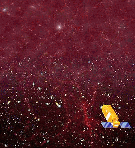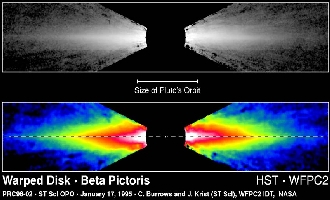

Mission Status Report #49 Star Date: August 23, 2001
FUSE in the News!!Caption: Two targets observed recently with FUSE. (Left) A graphic showing FUSE observing the distant quasar HE2347-4342, to study the intergalactic medium. (Right) A Hubble Space Telescope image of the young solar system around the star Beta Pictoris. FUSE Searched for evidence of molecular hydrogen gas in this object and, surprisingly, found none! (Click images above to see larger versions.)
Hello World, All continues to go extremely well on the FUSE project. All systems are nominal, including the spacecraft, science instrument, and ground systems performance. Which is not to say that things have been quiet around here! In fact, they have been quite busy. There are several parallel activities going on that are keeping the Science Operations team hopping. The first three years of FUSE science operations has been designated the "primary mission." After review by NASA, the FUSE project has been extended for two additional years of operations, which are to begin in December 2002. This is called the "extended mission." The trick is, we have to become much more efficient in operations in the extended mission phase because the funding level will be much lower than now. Hence, one of our major current activities is developing procedures that will permit a more autonomous operation. Instead of having people here 24/7, we will be able to operate with a much smaller staff, thus saving money! Operations on IRU-B continue smoothly after the gyro problem mentioned in in planning for a contingency where another gyro might fail. The gyros are most important for FUSE when it moves from target to target, an activity called "slewing." The team has developed a concept that would allow FUSE to find where it is after a slew and make its way to the next target even if we had no gyros in the system! The process would be much less straightforward than the way we do things now, but it is important to have a contingency procedure in place in the event that this situation arises. There is still much work to be done to implement and test the concept, and this will be an ongoing activity for months to come. In the mean time, FUSE continues to crank out the data at an impressive rate of about 750,000 seconds of science observing time per month. Science results continue to find their way into the professional literature, but a couple of recent results, highlighted at the top of this page, have found their way into the press and on-line news services. You can read more about these results at our local science summary pages, and from there you can find your way to more details if desired. To keep us rolling, NASA is putting the finishing touches on the selection of the next round of science program selections, which we call Cycle 3. Proposers should be notified in mid-September and observations for this cycle will begin in December 2001. Reported by: Bill Blair, Chief of Observatory Operations
|

